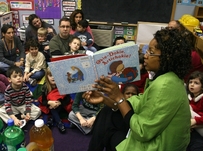 As I prepare for my presentation on actions that can be done with the read-aloud, I am reading the book "Who's Doing The Work? How to Say Less so Readers Can Do More" by Jan Burkins and Kim Yaris. The ideas that are discussed in the book are basically that, the person doing the work is the person who is learning and we want the students doing the learning. The authors have written a section in the book titled: What Makes Read-Aloud Special? I want to summarize this section because I will be using some of this content to help form my presentation in February. The authors list several reasons read-alouds are special.
Teachers have to provide models for how to notice and talk about aspects of text. (Rosenblatt, 2004) The read-aloud is at the beginning of the gradual release of responsibility which makes it easy to assume that the teacher is the one doing all the work. The teacher is responsible for bring the text to the students but you share the responsibility of making meaning from that text with your students. So, how do you implement a read-aloud? It doesn't really matter if you are reading a picture book to your students or if you are reading a chapter book the implementation is the same. We start like we would any lesson, with a plan. For a read-aloud to be successful you need to prepare. You need to select a text. Read the text and consider the points the authors noted.
It's also important for you to select some stopping points, questions (open ended), and look at some vocabulary words to teach and key ideas that might need some discussion as you read to the students. Look for places that may give you the opportunty to model a comprehension strategy, teaching a certain standard, and or lead to discussion of an idea. In order to do this preparation, you must read this book ahead of time. Also in your planning identify places where you think students might need additional support. When you are ready to begin, presentation is everything. Establish a routine of how and where you conduct a read-aloud, It could be on the carpet where students can sit comfortably and close enough to see the illustrations in the text. Read the text with fluency (you are modeling how you would like students to read) and with expression. Be sure to pause at your pre-planned stopping points and listen when you give them opportunities to discuss portions and if they have questions about the text (this means they are thinking as you read and may be correct or may be forming misconceptions) Remember to keep the read-aloud engaging and gauge whether or not the students are still focused on what you are reading. I have been exploring the idea of creating a checklist to use when planning your read-aloud. This checklist would help you effectivly plan for all the possibilites available for the text you have choosen to read that day. As I have been doing research, I have seen several different checklists and rubrics that can help with this intentional planning. You are making memories of enjoyment when you make a read-aloud enjoyable for your students, plus the benefits are widely supported by research; therefore, the more you read-aloud to students, the more these benefits increase. Thank you for reading; I would love your feedback... Burkins, J., Yaris, K. and Moser, J. (n.d.). Who's doing the work?. http://www.flickr.com/photos/wwworks/ (Picture Credit)
0 Comments
Leave a Reply. |
AuthorPearl Garden, Ed.D has completed her dissertation research involving understanding the vocabulary instruction practices of early grade teachers. She has a passion for the new and novice educator, and it is her goal to help educators tackle the achievement gap with her research findings. She will use this blog to share what she has learned in “pearls of literacy”. The ideas come from her dissertation titled “A Content Analysis of the Vocabulary Instruction Habits by Early Grade Teachers”. Archives
January 2024
Categories |
 RSS Feed
RSS Feed